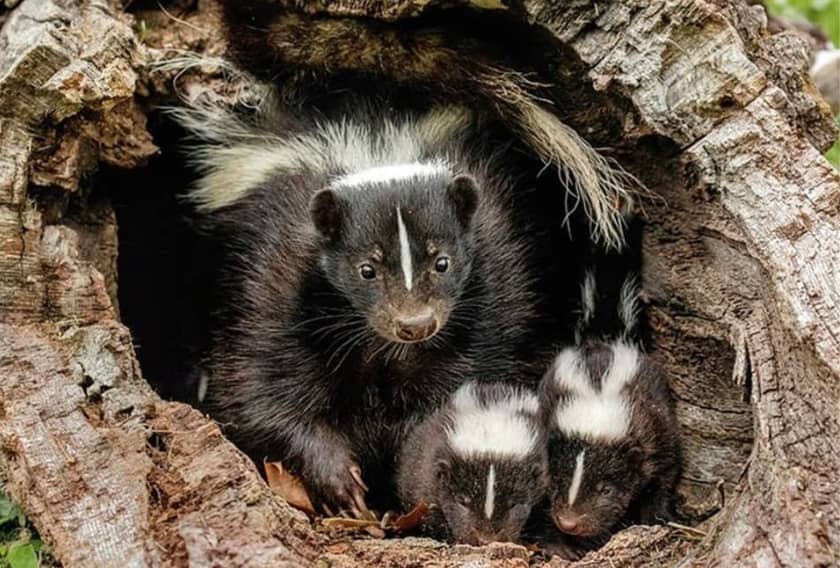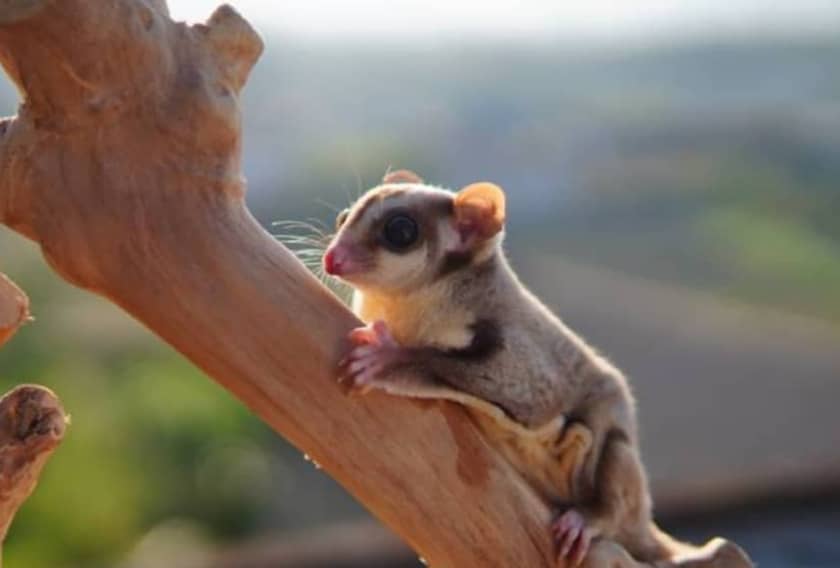There are many fascinating facts about sugar gliders, which make these tiny marsupials a special creature. Sugar Glider Facts include their physical characteristics and body adaptations, which make them unique creatures.
They have long tails, large ears, big round eyes, and tiny clawed feet. The gliding membranes are a broad flap of skin that connects the animal’s front and rear legs.

Because they are marsupials, the females, like kangaroos, have secret pouches on their bellies where they carry their young, Joey.
Sugar gliders may look like rodents and squirrels but they belong to the same family as Kangaroos and Koala bears.
The Sugar Gliders have got their name as they have a strong inclination towards sweet foods and can glide.
Sugar Glider Facts
A Sugar Glider is a unique creature that has raised curiosity among exotic pet owners. Some of the interesting facts related to their lifespan, anatomy, adaptations, and temperament are as follows.
Lifespan
Sugar gliders live 5-9 years on average when left in the wild.
However, in captivity, the expectancy can be greatly improved to 12-15 years with adequate housing conditions, dietary supplements, and enriching activities.
Size Information
Male sugar gliders weigh an average of 140 g, while females weigh an average of 115 g. The average adult sugar glider’s body length is between 5 and 7 inches, and its tail length is nearly the same as its body length. They measure roughly 24 to 30 cm (9 to 12 inches) in length.

Origin
Native to Tasmania, several nearby islands, Papua New Guinea, eastern Australia, and portions of Indonesia are sugar gliders. These arboreal species love to live in tree hollows and can be seen gliding from one branch to another in rainforests. These are rarely seen on the ground in their native habitats.
Sugar Glider Facts Related to Anatomy
Gliding Capabilities:
One of the most distinctive features of sugar gliders is their ability to glide. This is made possible by the patagium With this skin membrane that runs from their wrists to their ankles, sugar gliders can leap up to 150 feet (45 meters) in a single leap despite their small size. This skin expands out into a rectangular shape when they fly, thereby turning them into a miniature “kite.” This extra skin “retracts” against their body when not gliding, giving the appearance of a black line with ripples running along its edges.
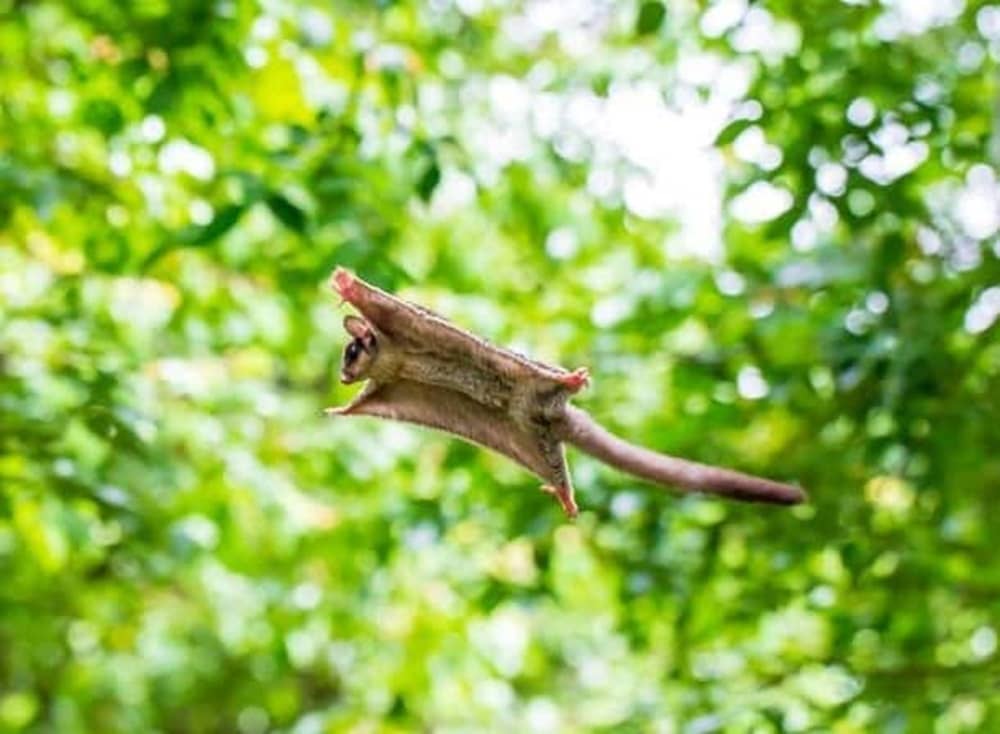
When launching, sugar gliders can precisely calculate glide ratios and distances by “bobbing” their heads side to side. This makes them incredibly sophisticated “aviators.” Once in the air, they use their tail as a rudder, angle their wrists and arms, and alter the tension of their “wings” to “steer” themselves toward their objective.
When a sugar glider leaps from a high perch, it spreads its limbs to stretch the patagium, allowing it to glide through the air. This gliding ability helps them escape predators and move quickly between trees in the wild.
The sugar gliders receive an additional lift when they leap because the concave portion of their skin unfolds and stiffens with the force of the jump.
The sharp claws along with opposable toes help them to climb and make a firm grip on the branches easily.
Nocturnal nature:
Sugar gliders are nocturnal creatures. This means that these are active at night and prefer to sleep during the day.
Large Eyes:
Sugar gliders also have large, expressive eyes that provide excellent night vision, a crucial adaptation for their nocturnal lifestyle
A Sugar Glider’s big eyes protrude out from both sides of its head. Their field of vision is greatly expanded as a result. It is thought that Sugar Gliders can only see red and various shades of gray due to the number of rods and cones in their eyes.
Role of Semi-Prehensile Tail:
Because of their semi-prehensile tails, sugar gliders can carry light items like leaves and twigs but are unable to hang from them like monkeys. Their tail, roughly half their total length when fully grown and typically measures around 6 inches, is mostly utilized as a steering mechanism to help them navigate while they glide through the air. Their long, prehensile tails help them balance as they navigate through the treetops.

Sugar Glider’s Ears:
Sugar gliders have sensitive ears that make them hear very feeble sounds. Though the whole body of the sugar glider is covered with fur, its ears are hairless. Moreover, each ear can move independently of the other helping it to pick up sound.
Sugar Glider’s Teeth:
As “diprodonts,” sugar gliders have two upper front teeth and two much longer, forward-pointing lower incisors. To get at sap and insects, they “scoop out” fruit and breakthrough tree bark in the wild using their teeth. The teeth of a sugar glider should never be worn down as they do not grow continuously like rodents. Therefore sugar gliders are considered good pets as compared to ferrets, hamsters, and squirrels.
Long Tongue:
Apart from its frequent usage for cleaning and grooming, its main function is to lick flavorful foods like juice and nectar. The juices from fruits and vegetables are frequently “sucked” out by sugar gliders, who then spit the remaining material out in tiny, half-moon-shaped pieces.

Do Sugar Gliders Have Hands or Feet?
The basic characteristic of sugar gliders is their lack of “feet.” Rather, they have four small hands that resemble ours. It is easier to climb, groom, and hold food or toys when each hand and foot has opposable thumbs. Due to the strong claws on each finger, it may “cling – almost like Velcro – wherever it lands.”
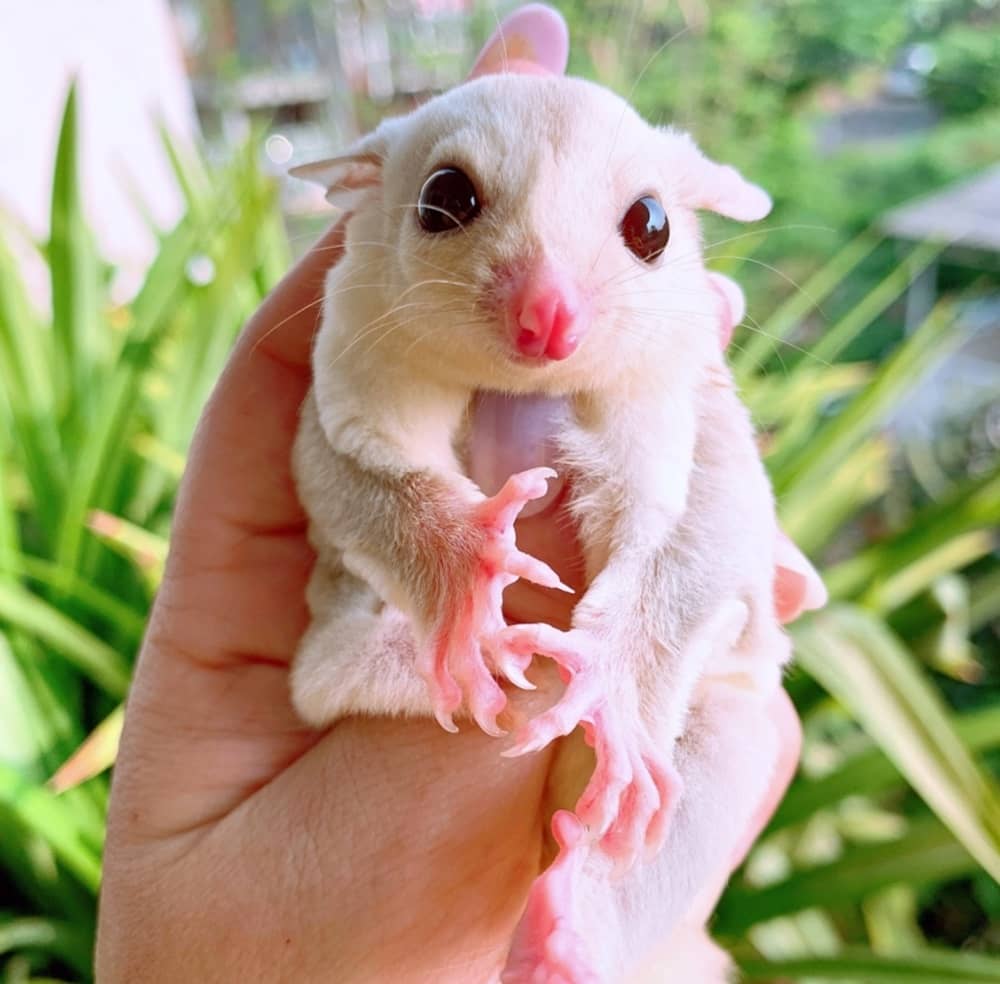
Growth in the Pouch
Sugar glider raises their young in a pouch on their mother’s belly. After the birth, the joey will crawl into the pouch and latch onto one of the mother’s four nipples once it gets there. It will spend the next sixty to seventy-five days in her pouch.
Grooming With Lower Hands
The second and third fingers of its lower hands are partially merged. This trait makes them particularly fascinating as it acts like a “comb” for personal grooming.
To aid in grooming, they can discharge a white, milky material from their tear ducts.
Scent Glands
Much like a ferret or skunk they have glands on their body to emit scent and mark with their urine. On gaining sexual maturity, male sugar gliders develop two scent glands on their bodies.
The first scent gland is a diamond-shaped, scent gland known as a “bald Spot” on their forehead. The second scent gland is small in size and located on the chest. These glands secrete an oil that mats down the fur and it appears like a “bald spot”.
Sugar Glider Facts Related to Temperament and Behavior
Being gregarious creatures, sugar gliders enjoy interacting with both their human caretakers and other members of their species. They have a reputation for being lively and inquisitive, and when given regular attention from an early age, they frequently form strong bonds with their owners.
Nonetheless, sugar gliders may be cautious and require some time to acclimate to unfamiliar surroundings and individuals. They can develop attachment and even ride around in a pocket or pouch, appreciating the warmth and security it offers, with patience and constant handling.
Social Creatures:
Sugar gliders are gregarious animals and shouldn’t be kept alone. Since they are nocturnal creatures in nature, it is best to keep them in couples or small groups to reduce stress and loneliness.
Communication Through Vocalizations
Sugar gliders communicate through various sounds such as crabbing, barking, hissing, chirping, clattering, and purring. Some sounds are similar to those made by a guinea pig, cat, or dog.
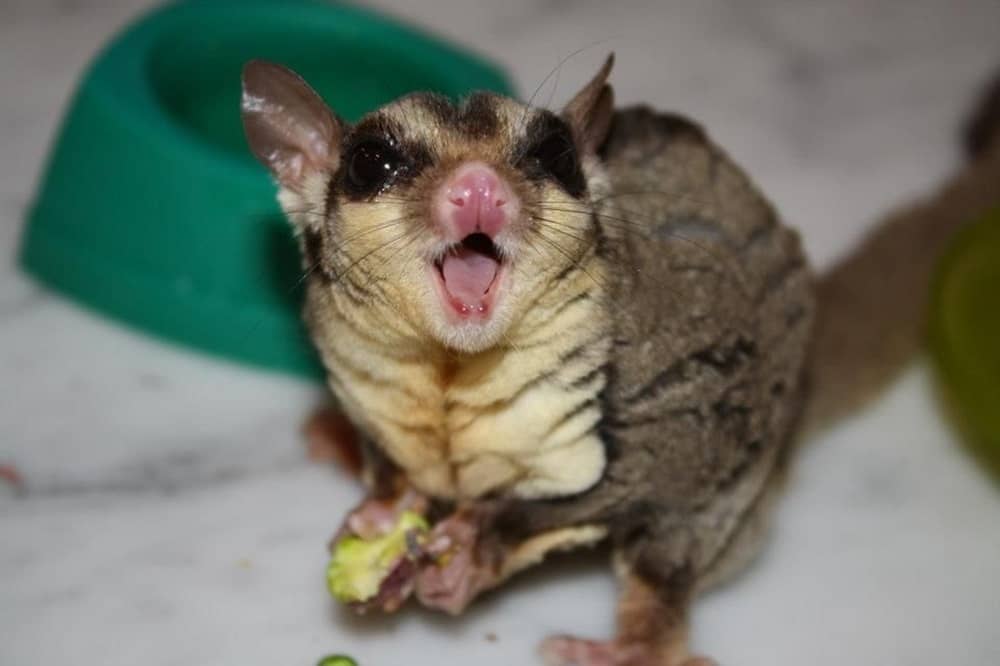
Omnivorous Diet
In the wild, sugar gliders are omnivores, feeding on a varied diet that includes sap and gum from trees, nectar, pollen, insects, and small vertebrates. In captivity, it’s important to replicate this diet to ensure they receive the proper nutrients.
The BML Diet, the HPW Diet, the TPG Diet, the PML Diet, and the VGV Diet are a few of the well-liked diets; each offers a unique strategy for meeting the dietary needs of these fascinating species.
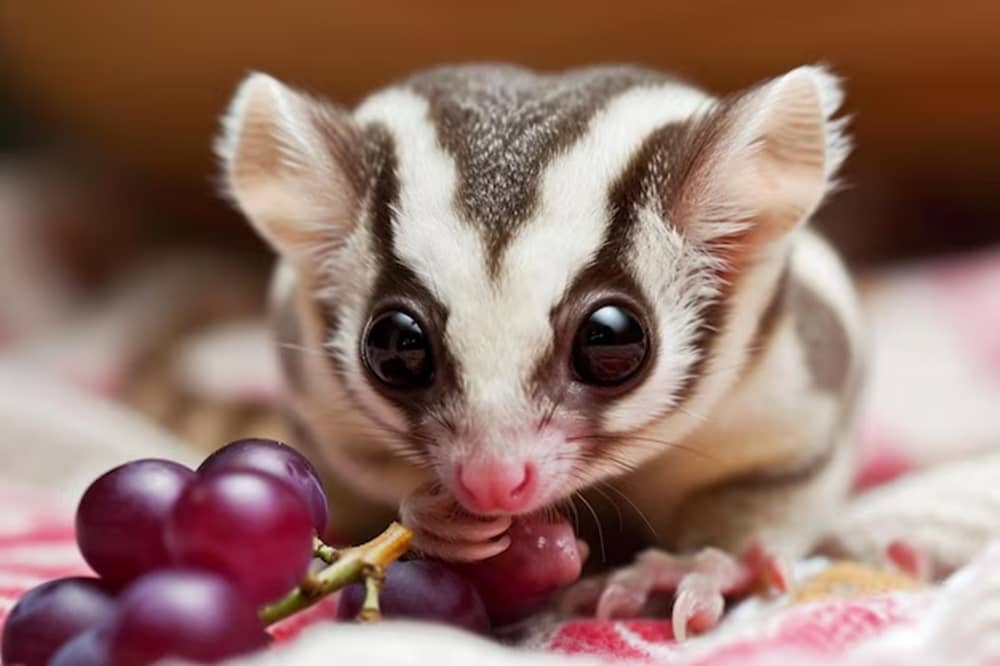
You may contribute to the well-being and extended lifespan of your sugar glider by being knowledgeable about the ingredients and benefits of these popular diets. Never forget that variety is essential, so feel free to add fresh produce, fruits, and occasional treats to their main diet. Your sugar glider will not only survive but flourish if given the right food.
Health
Sugar gliders may develop various health problems such as Actinomycosis, Diabetes Mellitus, Aflatoxicosis, Metabolic Bone Disease, Eye Disorders, and Tumors. A healthy diet supplemented with the right quantity of vitamins and minerals can keep your sugar glider healthy.
Other Important Sugar Glider Facts
- Sugar gliders are one of the smallest marsupials.
- It has been observed that these marsupials will leap upon flying moths and seize them. They have a 45-meter (148.5-foot) gliding capacity.
- In large colonies of 20 to 40 sugar gliders, two alpha males father most of the babies.
- After giving birth, females raise their young in a pouch on their abdomen for ten weeks.
- As the demand for sugar gliders as pets is escalating, these wild animals are picked from their natural habitats and traded illegally. However, it is not listed in IUCN, CITES, or USFWS.
- When they are angry, gliders emit a chattering sound that sounds like a little dog barking. When they do this, they sag back. If this warning doesn’t work, they launch a fierce attack.
- Furthermore, sugar gliders have a special capacity called “torpor,” which enables them to stop breathing and drop their body temperature for up to weeks at a time. Sugar gliders enter a state known as torpor when their body temperature drops. This allows them to save energy and endure the winter when there is less food available.
- After 10 months, young gliders usually depart to establish their colonies.
- It is an important pollinator for native plants.
- Sugar Glider is a popular pet in the United States and Japan


